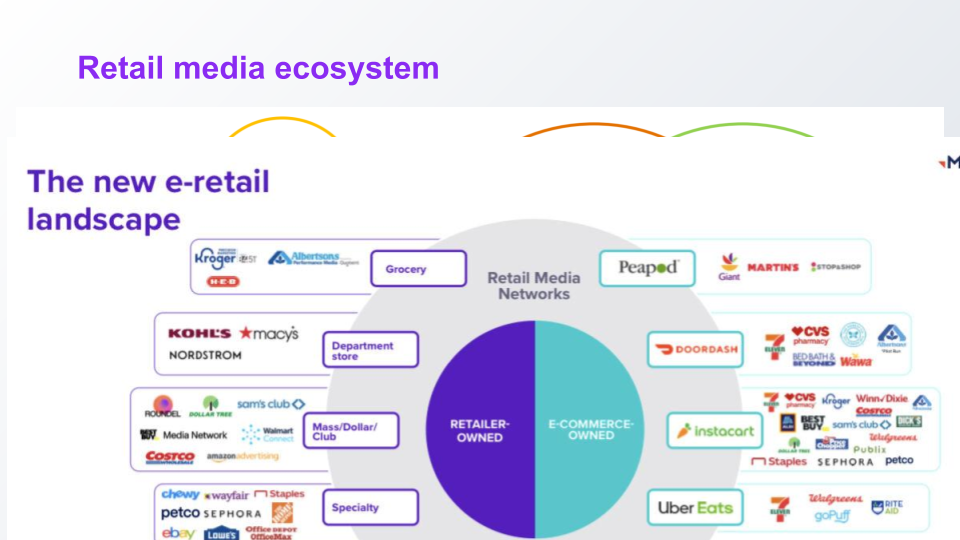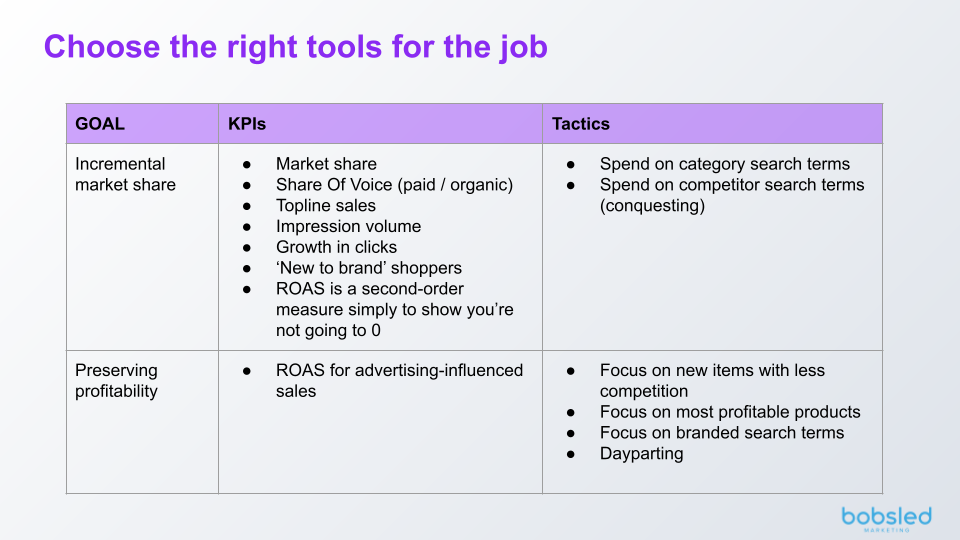The end of the year is often spent in reflection of the last 12 months, analyzing trends and campaign strategies to find out what went well - and what didn’t. In order to form the best new initiative for the upcoming year, Bobsled experts have observed eCommerce trends and noticed how those trends intersect to discover the best ideas and biggest challenges facing us in the new quarter.
In late October, Bobsled CEO Kiri Masters introduced brands and prospective Amazon sellers to key priorities for the new year with “7 Critical Challenges for Omnichannel Brands in 2022”. The webinar provided viewers with seven big areas of improvement to work on in order to increase profits in the upcoming year and get a leg up on their competitors.
Attendees learned:
- Important tools and resources that are a must-have for omnichannel brands looking to grow in 2022
- 7 major hurdles that sellers of all sizes should expect in the new year
- How to get ahead of the curve by employing certain tactics and strategies before the end of the quarter
Read our important takeaways from the webinar and review the 7 most critical challenges for omnichannel brands in 2022.

1. The Content Treadmill
It can seem like a challenge to be constantly churning out new content, but that is what helps brands see a significant lift in sales and conversions. Our Bobsled experts often recommend enhancing the product display pages (PDP), and for good reason: it can help drive more traffic to your store. Not to mention, increased conversions can also reduce ad costs over time. On Amazon, brands that add visual content and enhance their A+ content are likely to lift their sales between 15% - 58% on average.
In August of 2021, Walmart announced that they will be getting rid of their enhanced content, including all videos. It’s unclear why they decided to do this, but it is possibly only a short-term move. It can be difficult to execute digital shelf syndication in a way that purely drives up sales. That’s why it is important to always invest in high-end content no matter what else you do as part of your strategy.
2. Supply Chain Pain
An increasing number of brands are starting to raise their prices across the board. This means that you should be doing the same thing. In fact, you should do so right away so you have as much time as possible to enjoy bigger margins since 2022 could throw a disruptive hat into the ring.
Not many things are sure in life, but inflation is one of them. Prices will be going up no matter what. Surprisingly, buying rates are also going up. This has caused what many people in eCommerce have dubbed “Shipageddon”.

Shipageddon
Many retailers are increasing inventory order numbers in their bid to stay ahead of the game. While experts expect this dramatic shipping backup to be cleared up in early 2022, it has certainly added a layer of difficulty in the already chaotic time of the holiday season.
There is even an excess of inventory in these shipping systems, and this is adding to the shipping delays and mailing mixups. With sudden stock increases and no ability to ship them out, sellers are going to be left with plenty of extra items on their hands. We expect that there will be a platform-wide clearance sale of sorts happening among brands from early to mid-2022.
Sellers will be sitting on mountains of extra products that they will likely be eager to sell by the summer, and we may even see some record-breaking clearance sales on or around Amazon Prime Day 2022. In the meantime, brands have to deal with the fact that the Q4 scramble makes for a leaner holiday season that will be made up for in a couple of months in 2022.
3. Profitability Paradox
The profitability imperative is an important thing to look at, especially in the wake of the pandemic. As 2022 is upon us, digital sales are on a bigger rise than ever. They have gone from being a small percentage of sales to taking up a vast majority of sales - but channel profitability has not yet caught up. This is because eCommerce was rarely, if ever, the biggest focal point of businesses. But now that brands are focusing solely on digital platforms and internet sales, there is now a sudden urgency in showing proof of profitability.
SKU Probability Factors:
- Pricing (ASP)
- Manufacturing costs
- Scale
- Amazon fees
- Packaging
- Supply chain costs
A Digital Shelf Institute (DSI) research expert discovered that one of the biggest ways to drive up profits is to revisit packaging design and digital artwork. It is time to cater products to the digital eCommerce world rather than for in-store packaging and storage. With an increasing amount of supply chain issues and a bigger spotlight on Amazon shortage and chargeback fees, a clear and intentional focus on eCommerce profitability is absolutely necessary.
Listen to The Dirty Little Secret of Profitability in eCommerce Episode of Ecommerce Braintrust
4. More Channels, More Complexity
Like many seller industries, eCommerce was originally considered a niche or a cutting-edge way to do business, but now it is certainly the norm. The future of retail has arrived, completely transforming the focus of sellers and brands. The biggest objectives of the year should center on increased profitability through eCommerce sites.

The last few years have exploded with a myriad of new retail media options for brands to take advantage of. Advertising is extending across many platforms to reach important stakeholders in a niche. For example, a brand in the DIY niche may want to look to titans like Lowe’s and Home Depot for best eCommerce practices.
Allocating marketing spending is likely among the biggest challenges facing the growing number of channels online. The solution? More integration with 3rd party tools and accessibility to a platform decision filter.
5. Providing ROI within the “Halo Effect”
With studies showing that every $1 generated by retail media campaigns earns up to $11 spent in-store, brands are starting to rationalize their marketing expenditure. It is possible to benefit from the halo effect created by an omnichannel advertising campaign when the strategy is done, and ROI is measured, correctly.

Big retailers like Costco, CVS, and Target generate physical in-person sales for other corporations like Instacart. This means that Instacart spends most of its budget on digital media and advertising, but still generates profits through the sale of real items. By considering the halo effect of retail media, brands can use their digital marketing capabilities to prove the power of eCommerce.
6. Powering Up Product Reviews
There’s a big reason why sellers are so keen on having stellar reviews: An improvement from 4.7 to 4.8 stars can bring a 40.9% increase in conversions alone. However, that is easier said than done, as it can be very difficult to gain customer reviews. In fact, this year saw some major changes in the way Amazon handles reviews making it even more challenging for brands to gain product reviews. Not only was the Early Reviewer Program shut down, but Amazon also removed the ability for sellers to comment on customer reviews.
One bright spot on the map is the fact that brands can now directly respond to those Amazon customers who left reviews, instead of only replying to the review. It is easier than ever to establish direct interaction with the customers that matter most. The larger pool of trusted reviews you have, the bigger of a competitor you become to others.
7. Dark Horse: FBA Aggregators
FBA aggregators can affect brands in a number of ways, especially when they are intent on finding sellers who want to make a quick profit. The more money that these private umbrella companies make, the more difficult it becomes for independent sellers and brands to find the funding that can sustain them into the new year.
Aggregators also affect brands through the following means:
- Extreme data orientation with the ability to find flaws in the way independent sellers operate
- Hiring and hoarding the best talent across all industries
- Seemingly limitless funds for advertising and eCommerce conquesting
However, nobody is an impenetrable fortress. Despite the deep pockets and long reach of these FBA aggregators, they are still impacted by the same inventory issues that independent brands face. Additionally, FBA aggregators typically hone in on Amazon alone. Brands and sellers can escape the influence of aggregators by taking an omnichannel approach when advertising and engaging with customers.
NEED HELP MANAGING YOUR SELLER BRAND IN 2022?
Book a free consultation now.
